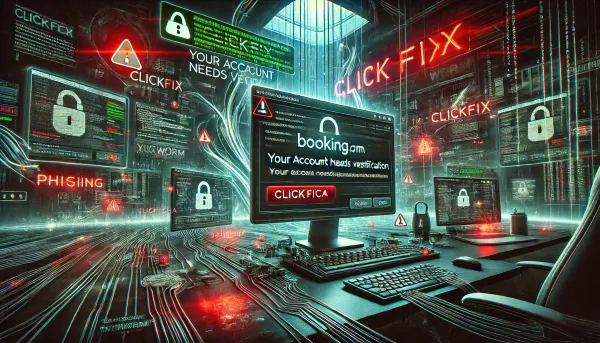
ClickFix Phishing Campaign- Threats in Cybersecurity 2025
The digital landscape continues to evolve, and with it, the tactics employed by cybercriminals. Among the latest manifestations of this evolution is the ClickFix phishing campaign, which has been attributed to the threat group known as Storm-1865. This campaign, first identified in December 2024, exploits a novel social engineering technique to target hospitality organizations globally. Understanding the mechanisms and implications of ClickFix is vital for cybersecurity professionals as these threats become increasingly sophisticated and pervasive.
The ClickFix Attack Mechanism
Overview of ClickFix
ClickFix is a social engineering technique that utilizes fake error messages to trick users into executing destructive commands on their systems. In these phishing attempts, recipients receive emails that impersonate reputable entities, most notably Booking.com.
The typical attack flow involves the following steps:
-
Phishing Email Delivery: Targeted emails are crafted to resemble official communications from Booking.com, which may include notifications about negative reviews, account verifications, or urgent inquiries.
-
Fake CAPTCHA Interaction: Upon clicking the embedded links or attached documents, users are redirected to a fraudulent page that presents a simulated CAPTCHA challenge. This step is designed to invoke a sense of urgency and legitimacy.
-
Executable Commands: Users are prompted to use keyboard shortcuts to open a Windows Run command window, where a malicious command copied to the clipboard is executed. This command bypasses many traditional security tools as it leverages legitimate system binaries, such as mshta.exe, to download various malware payloads, including credential stealers and Remote Access Trojans (RATs).
Malware Families Involved
The ClickFix campaigns have been linked to several notorious malware families, including:
- XWorm: A versatile malware capable of exfiltrating sensitive information.
- Lumma Stealer: Known for its efficiency in stealing login credentials and financial data.
- VenomRAT: A powerful RAT often used for espionage and information theft.
- AsyncRAT and Danabot: Recognized for their robust backdoor capabilities.
- NetSupport RAT: Exploits legitimate remote access tools to maintain persistence and control over compromised systems.
Threat Landscape and Implications
Target Demographics
The primary targets of the ClickFix campaign are hospitality organizations, including hotels and travel agencies, particularly those utilizing Booking.com. The breadth of this campaign spans North America, Oceania, and various regions across Europe and Asia.
Evolving Tactics of Storm-1865
Microsoft’s threat intelligence team has noted that the correlation of ClickFix with prior methodologies employed by Storm-1865 represents a significant evolution. Historically, this actor has focused on phishing attacks targeting e-commerce platforms and email services to propagate financial fraud. The incorporation of ClickFix into their arsenal showcases an adaptive strategy to evade conventional detection mechanisms.
Defensive Strategies Against ClickFix
To mitigate the risks posed by ClickFix and similar phishing attempts, cybersecurity professionals should consider adopting the following measures:
-
User Education and Awareness: Regular training sessions should be conducted to educate employees on recognizing phishing attempts and conducting safe online practices, particularly regarding urgent requests for action.
-
Email Verification Protocols: Encourage the verification of sender addresses and scrutinizing the content of communications for discrepancies indicative of phishing scams.
-
Incident Response Planning: Develop and enforce a robust incident response plan tailored to identify and react swiftly to phishing attempts. This should include clear reporting mechanisms and systematic analysis procedures.
-
Adoption of Advanced Security Solutions: Deploy solutions that include anti-phishing protections, URL filtering, and multi-factor authentication to add additional layers of security.
-
Regular System Audits and Updates: Enterprises must ensure that all systems are regularly audited and kept up to date with security patches to minimize vulnerabilities exploited by malware.
Recent Developments in the Cyber Threat Landscape
As of 2025, cybersecurity experts have reported a notable increase in phishing attacks utilizing variations of the ClickFix technique, including:
- Fake CAPTCHA Challenges that evolve into sophisticated multi-stage payload delivery systems, often leading to well-known infostealers such as Lumma and Vidar.
- Malicious Packages Distributed via Reputable Platforms: Threat actors have started leveraging platforms like GitHub to distribute malware hidden within seemingly benign projects, highlighting the necessity for vigilance even within trusted ecosystems.
Reports indicate a more extensive adoption of ClickFix by both cybercriminal organizations and Advanced Persistent Threat (APT) groups, including documented cases of state-sponsored actors employing similar tactics to enhance the effectiveness of their campaigns aimed at corporate espionage.
Conclusion
The ClickFix phishing campaign exemplifies the adaptive nature of cyber threats within the hospitality sector and underscores an escalating arms race between threat actors and cybersecurity professionals. Understanding these tactics not only enhances the security posture of organizations but also emphasizes the need for a holistic approach to cybersecurity that prioritizes user education and robust technical defenses. As we further explore the complexities of digital threats, staying aware of evolving techniques like ClickFix will be crucial in safeguarding sensitive information and operational integrity.
By remaining proactive and informed, cybersecurity teams can thwart these sophisticated attacks and protect their organizations from increasingly cunning threat actors.